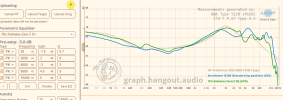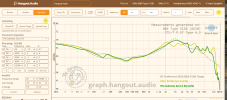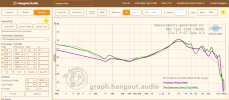I see what you saying. I might have not been completely true to you, or maybe now after you point out those stuff, there are few things that aren't "perfect" so to speak with the PEQ on the Zero 2.Last thing: be careful with those graphs because they can be misleading and are compensated on the JM-1 curve. Putting them in overlay on the Harman curve (see photo), in my opinion Blue 2 does the opposite of what you are looking for.
At first glance it seems very screaming and closed and has that depression around 200 Hz (which I hated on Red but here it is worse) that takes away body from the timbre to give you the impression of detailed mids. It seems like an improvement in the extension of the treble compared to Red, but a Downgrade in the rest and in any case I do not see real upgrades compared to Zero2.
In the photos there is also the comparison compared to Zero2 with EQ, IE200 (there you have a real upgrade on everything but especially on the treble) and Performer 5, for example.
You will have time to think about it. For the rest I am happy if I managed to make you useful in some way.
I had to cut down the 15000 Peak from 7 to 5 db, and the 9500 to from 5 to 4.5 db. Still of course missing the extension, but on quite of few songs the high can get a bit harsh. You cant really see the difference on the graph, but those slight cuts make it a bit more less sharper. It's like slight painful-pleasure to listen to, if you get me.
Blue 2 treble extension looks good, but overall the harman bump needs to be trimmed down for me and probably that dip in the 200s to be raised (which i havent tested, but by judging from your replays i think you are getting a grip of my likings). Maybe the slightly calmer air will be to my taste?
The Performer 5 looks great overall, its even on sale atm for 180$, but should i risk and blind buy it, until i'm not sure exactly where i am in the upper range? Reviews look great though.
The Hexa somehow matches pretty well the Zero's PEQ, just no bass, there is another Truthear set called Pure, which is basically Hexa 2. Feedback about it is very positive, but no idea what's its signature.
From what i can understand from you, if the FR isn't really far from your preferred taste (give or take 4-5 db) and mostly if above 10k its in your sweet spot, you can make any IEM (if the drivers allow it) to be EQ in 98% to each other, right? Maybe with silicone tips the graph would of look differently, or no? My Zero's with those Foam tips from Aliexpress sound very muffled, completely different and unenjoyable.
P.S - If the other fellow forum member doesn't take your invitation offer, i might! I love pizza (had a girlfriend which was joking me that i can eat pizza for a living
Attachments
Last edited:



